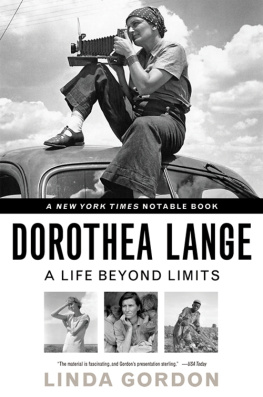Partridge - Dorothea Lange: Grab A Hunk of Lightning
Here you can read online Partridge - Dorothea Lange: Grab A Hunk of Lightning full text of the book (entire story) in english for free. Download pdf and epub, get meaning, cover and reviews about this ebook. year: 2013, publisher: Chronicle Books LLC, genre: Non-fiction. Description of the work, (preface) as well as reviews are available. Best literature library LitArk.com created for fans of good reading and offers a wide selection of genres:
Romance novel
Science fiction
Adventure
Detective
Science
History
Home and family
Prose
Art
Politics
Computer
Non-fiction
Religion
Business
Children
Humor
Choose a favorite category and find really read worthwhile books. Enjoy immersion in the world of imagination, feel the emotions of the characters or learn something new for yourself, make an fascinating discovery.

- Book:Dorothea Lange: Grab A Hunk of Lightning
- Author:
- Publisher:Chronicle Books LLC
- Genre:
- Year:2013
- Rating:3 / 5
- Favourites:Add to favourites
- Your mark:
- 60
- 1
- 2
- 3
- 4
- 5
Dorothea Lange: Grab A Hunk of Lightning: summary, description and annotation
We offer to read an annotation, description, summary or preface (depends on what the author of the book "Dorothea Lange: Grab A Hunk of Lightning" wrote himself). If you haven't found the necessary information about the book — write in the comments, we will try to find it.
Dorothea Lange: Grab A Hunk of Lightning — read online for free the complete book (whole text) full work
Below is the text of the book, divided by pages. System saving the place of the last page read, allows you to conveniently read the book "Dorothea Lange: Grab A Hunk of Lightning" online for free, without having to search again every time where you left off. Put a bookmark, and you can go to the page where you finished reading at any time.
Font size:
Interval:
Bookmark:


FOR ALLYSON L. FEENEY
AMERICAN MASTERS is a production of THIRTEEN for PBS
Creator + Executive Producer: Susan Lacy
Series Producer: Prudence Glass
Supervising Producer: Julie Sacks
Text copyright 2013 by Elizabeth Partridge.
Photographs copyright by Dorothea Lange Collection, Oakland Museum of California, the City of Oakland. Gift of Paul S. Taylor, unless otherwise noted.
All rights reserved. No part of this book may be reproduced in any form without written permission from the publisher.
constitutes a continuation of the copyright page.
ISBN 978-1-4521-3196-2
The Library of Congress has cataloged the print edition under: ISBN: 9781452122168.
Design: Annabelle Gould
Typeset with National by Kris Sowersby
Frontis image: Migrant Mother, 1936
Chronicle Books LLC
680 Second Street
San Francisco, CA 94107
www.chroniclebooks.com
Dorothea Lange almost didnt take her most famous photograph, Migrant Mother. It was early March 1936, the end of a cold, miserable winter. Dorothea had been on the road for nearly a month photographing the desperate living and working conditions of migratory farm workers in California. She was worked out, weary to the bone. Shed packed up her cumbersome camera equipment and was driving north on Highway 101, thoughts of home filling her with relief. As she drove past Nipomo, California, a small handmade sign flashed by, Pea Pickers Camp. She kept her foot on the gas pedal.
A year earlier Dorothea had been to Nipomo on her first assignment for the government. She knew conditions for the migrant pea pickers were desperate. She drove on, arguing with herself, Havent you plenty of negatives already on the subject? Isnt this just one more of the same? Twenty miles farther, almost without realizing what she was doing, she made a U-turn and headed back.
Two weeks of sleet and steady rain had caused a rust blight, destroying the pea crop. There was no work, no money to buy food. Dorothea approached the hungry and desperate mother, huddled under a torn canvas tent with her children. The family had been living on frozen vegetables theyd gleaned from the fields and birds the children killed. Working quickly, Dorothea made just a few exposures, climbed back in her car, and drove home.
Dorothea knew the starving pea pickers couldnt wait for someone in Washington, DC to act. They needed help immediately. She developed the negatives of the stranded family, and rushed several photographs to the San Francisco News. Two of her images accompanied an article on March 10th as the federal government rushed twenty thousand pounds of food to the migrants.
The San Francisco News reported Dorothea happened by chance to be at Nipomo.

I was following instinct, not reason; I drove into that wet and soggy camp and parked my car like a homing pigeon.
Destitute Pea Pickers in California. Mother of Seven Children. Age Thirty-Two.
Nipomo, San Luis Obispo County, California, 1936
Two tragedies in Dorotheas childhood stamped their indelible marks on her, and shattered the respectability her family had carefully cultivated from the moment they disembarked from steerage in the United States. In the late 1850s, Dorotheas grandparents had made the arduous ocean voyage from Germany, sleeping below deck in rough bunk beds, eating food theyd carefully packed. Like thousands of other German immigrants they ventured no farther than Hoboken, New Jersey. They immigrated with many of their brothers and sisters, skilled engravers, musicians, teachers, and seamstresses. Everyone worked hard, and soon steerage was a tight-lipped secret. By the time Dorotheas parents married in 1894, both of their families were part of the thriving middle-class German enclave in Hoboken. Her father, Henry Nutzhorn, was a partner in a small law firm, and her mother, Joan Lange Nutzhorn, a soloist with the church choir. They rented a large, stately brownstone, and hired a maid to take care of the housework.

Dorothea and Martin
Hoboken, New Jersey, c. 1905, Photographer Unknown
Dorothea was born at home on May 26, 1895. Six years later, her younger brother Martin was born. Dorothea claimed she had been born tired. Ive been tired all my life, every day of my life. I remember when I was only maybe ten years old being as tired as a human being could be, and wishing that I could sleep forever just because I was so tired. Her weariness may not have started at birth, but might have been a legacy of the polio she contracted when she was seven, in the summer of 1902.
The virus attacked the nerves in Dorotheas right leg, weakening muscles, and tightening tendons. With no way of knowing how it spread, and no cure available, frightened neighbors shunned both patients and their families. Patients were isolated, their clothing and toys burned. When Dorotheas fever finally broke and the crisis was over, her damaged right leg forced her to walk with a rolling gait, dropping her shoulder slightly, and pulling her leg forward.
Despite public health knowledge to the contrary, polio was considered a lower- class disease, associated with poverty, filth, and crowding. With the illness came shame. When they went on doctor visits, Dorothea felt that her mothers respect for the doctors authority veered on obsequiousness. And if they spotted people they knew on the street, Joan insisted, now walk as well as you can. Dorothea hated that her mother cared what other people thought.
Her weakened right leg made it hard to keep up, and soon other kids nicknamed Dorothea Limpy. Polioand the limp it leftprofoundly changed her life. I think it perhaps was the most important thing that happened to me, she said later, and formed me, guided me, instructed me, helped me, and humiliated me. All those things at once.
Looking through her parents bookshelves one day, Dorothea found a large volume of Shakespeares plays. She read them voraciously, loving the stories. Henry and Joan didnt believe she could really read the tiny print. They laughed at her, questioning her about what shed read. When her astonished father realized she was really reading the plays, he hired a coach and horse and took her to see A Midsummer Nights Dream. There were no seats left when they arrived, so he swung her up on his shoulders and stood for the entire performance. For Dorothea, it was a magical evening.
Ordinary, everyday things that others didnt notice caught Dorotheas eye. Her grandmother Sophie, a difficult, temperamental woman, was an exquisite seamstress. Laying her fabrics out on an oval walnut-topped table, she marked her seams with a pattern wheel. Over the years, the sharp points of the wheel left hundreds of lines made of tiny marks, until the arching, dotted lines covering the tabletop looked like a modern design to Dorothea.
One day she overheard her grandmother Sophie say to Joan in her German dialect, that girl has line in her head.
Next pageFont size:
Interval:
Bookmark:
Similar books «Dorothea Lange: Grab A Hunk of Lightning»
Look at similar books to Dorothea Lange: Grab A Hunk of Lightning. We have selected literature similar in name and meaning in the hope of providing readers with more options to find new, interesting, not yet read works.
Discussion, reviews of the book Dorothea Lange: Grab A Hunk of Lightning and just readers' own opinions. Leave your comments, write what you think about the work, its meaning or the main characters. Specify what exactly you liked and what you didn't like, and why you think so.













